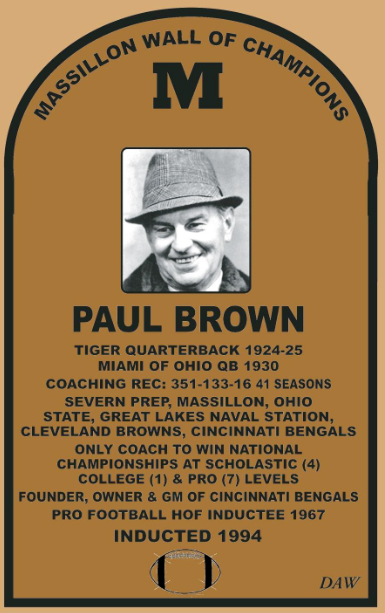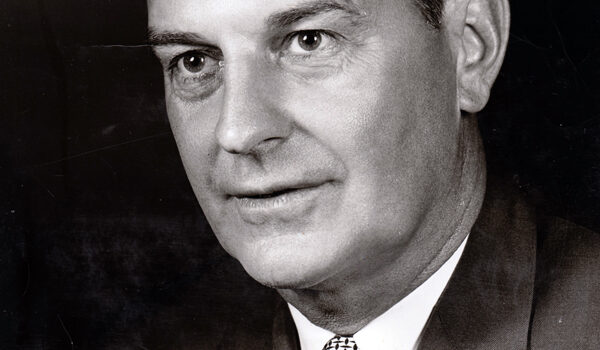
Paul Brown – Wall of Champions
Coach Paul E. Brown is unique in the football world in that he has won national championships at all levels: high school, college and professional. And, while he is certainly responsible for the spearheading the success achieved by the Massillon Tigers throughout their long history, he is also perhaps considered as the father of the modern professional game as well, as evidenced by his influence within the ranks of owners throughout the NFL.
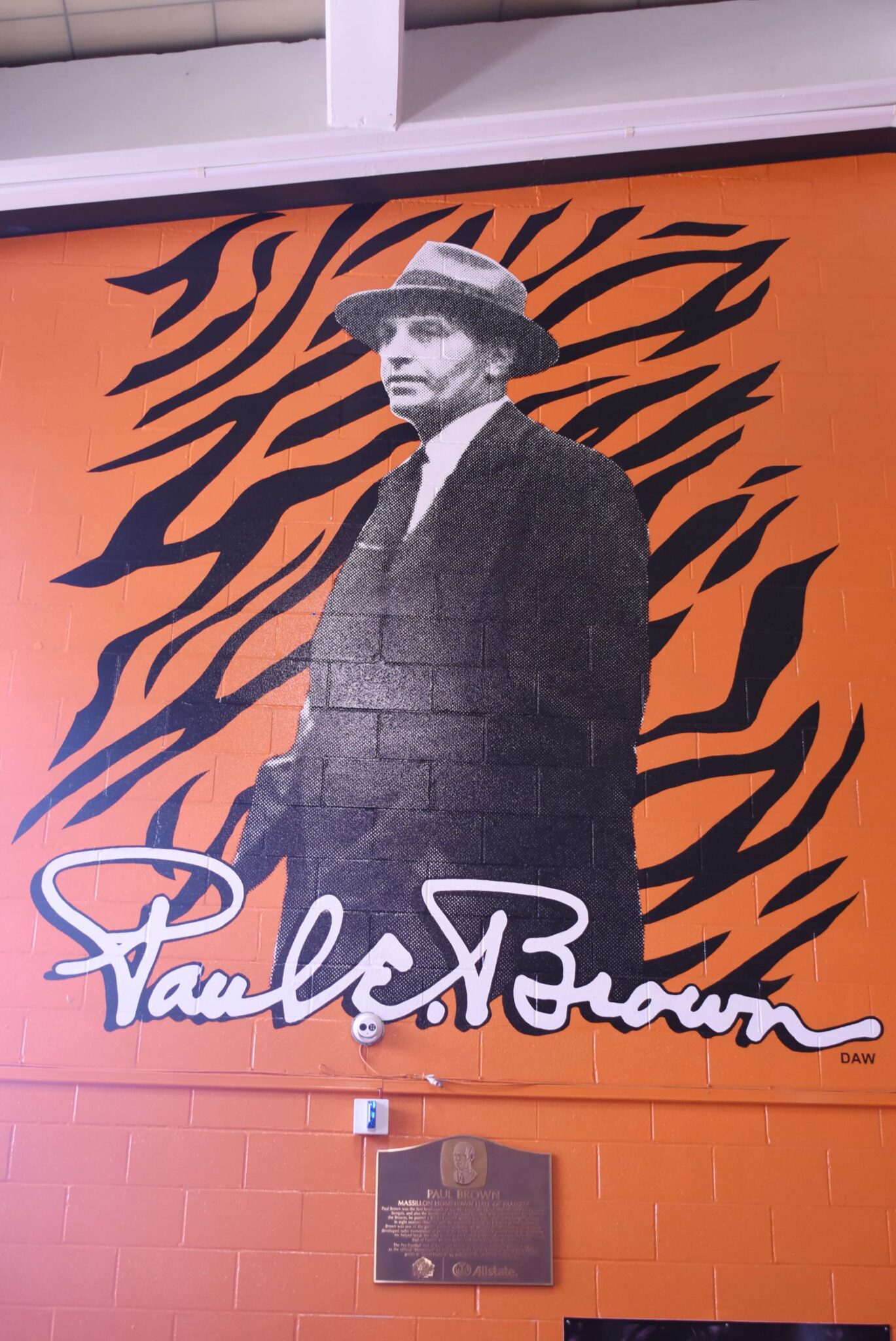
While a myriad of books have been authored that appropriately convey the Paul Brown story, from his early days at Massillon to Ohio State and throughout his lengthy professional career with the Browns and Bengals, it is not the intent of this biography to cover every aspect of his life. It does, however, focus mostly on his time in Massillon as a player and then a coach, while amply making the case for induction into the Massillon Wall of Champions, the highest honor that can be achieved by a former Massillon Tiger.
Massillon has always relished the reputation of being a football town, from its earliest beginnings in 1891 to the current years as an annual state championship contender. So what better place for Brown to springboard his career. The community has always rallied around its football program through copious attendance at the games and participation in the many off-season events. And it has continuously provided generous financial support when needed. Plus, the facilities are considered second to none. “The difference between the people of Massillon and people in other places is that Massillon people care more, said former Tiger coach Bob Commings. (1)
The Early Years
Brown was born on September 7, 1908, in Norwalk, Ohio, to parents Lester Brown(e), a railroad dispatcher, and Ida Sherwood Brown. In 1915, while Paul was in the fourth grade, his father was transferred to Brewster. So the family set up residence in nearby Massillon.
Immediately introduced to playground football, Brown later joined the Jones Junior High football team when he came of age. However, because of his smallish stature, he received little playing time. Nevertheless, Brown did excel in track as a pole vaulter, where he was able to compete at the varsity level as a freshman.
Massillon High School
Now at Massillon’s Washington High School as a sophomore, Brown received his first exposure to high school football under the tutelage of the very successful Coach Dave Stewart (38-9). His position was quarterback.
In 1923, the team produced an 8-2 record, including a victory over 9-0 Canton McKinley. The losses were to Youngstown South and Harrisburg Tech, PA, although Harrisburg was considered as an adult high school.
In 1924, the Tigers finished 9-1 with a 6-0 win over McKinley and a lone loss to Youngstown South via forfeit following Stewart’s disagreement with the referees. But 1924 also marked the year that Brown became a starter at quarterback.
In Brown’s senior year the team finished 7-2, losing 6-3 to McKinley and 7-0 to Akron South. But they did defeat Alliance 13-6 in a game that is considered by this website as one of Massillon’s greatest ever victories during the 1920s. For the season Brown tossed five touchdown passes.
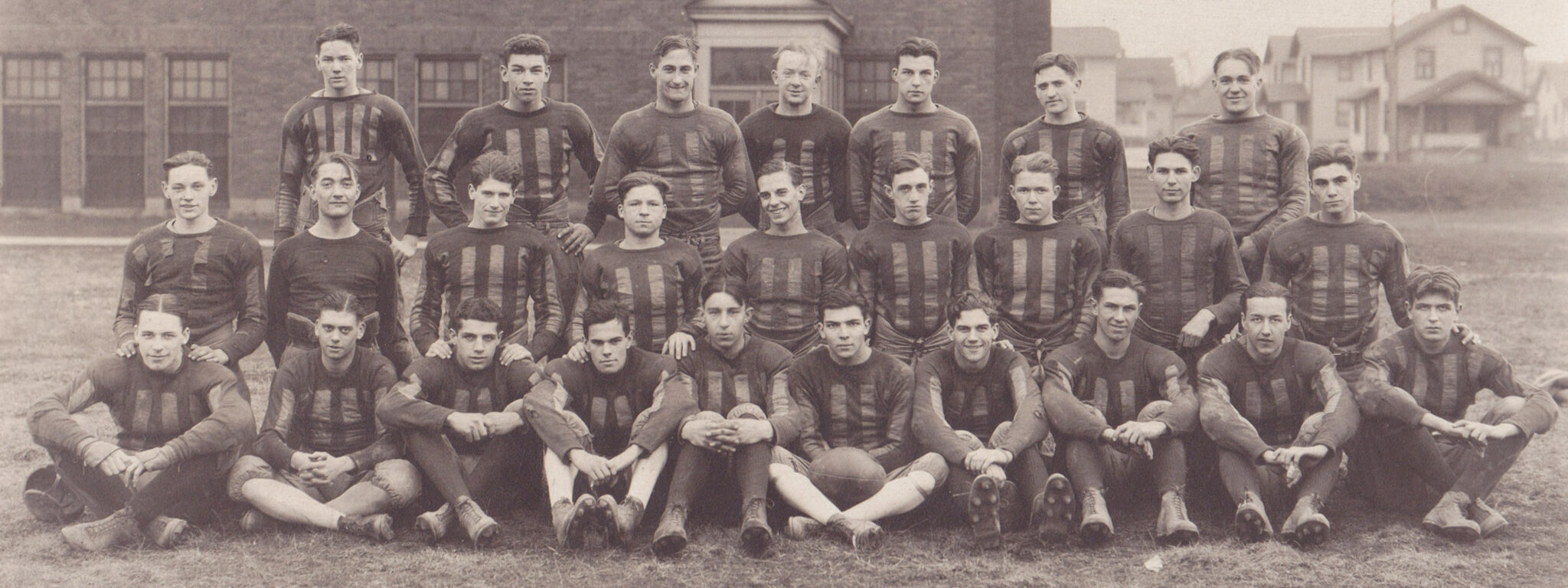
Massillon’s 1925 team. Paul Brown is pictured in the second row, fifth from the left.
Although he was a 2-year starter for the football Tigers and shared in the successes the team achieved on the-field, his greatest takeaway was his relationship with Coach Stewart, whose influence led him to pursue a career in football coaching.
“Dave Stewart was wonderful,” said Brown. “He gave me a love of football and winning.” (2) “Dave Stewart made me enjoy coaching,” said Brown. “I’d go over to Sharon (PA) before I went back to school (college) in the fall and help him out. I was just obsessed with it. I enjoyed it. I was a goner. He recognized this.” (1)
Brown was a 3-sport athlete, also lettering in both basketball and track.
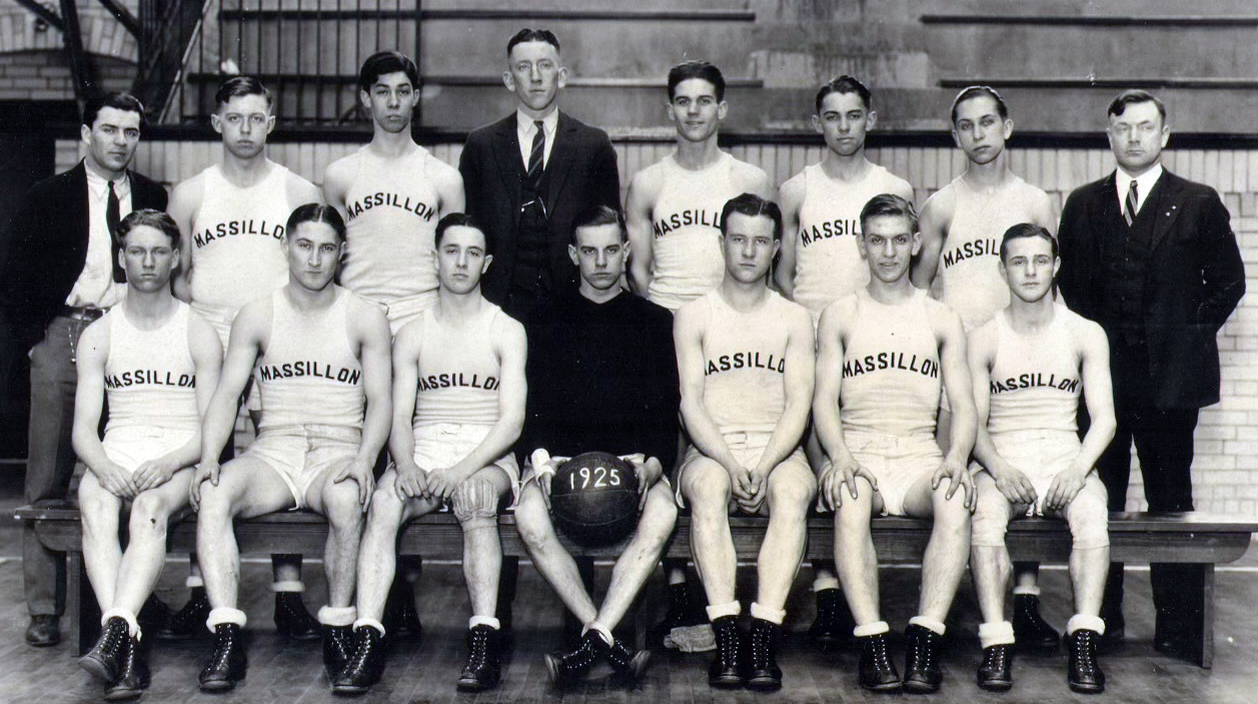
Massillon’s 1925 basketball team. Paul Brown is pictured in the the first row holding the basketball. Coach Dave Stewart is pictured in the second row, fourth from the left.
College
After high school Brown enrolled at Ohio State, but it just didn’t feel right to him. So he immediately transferred to Miami of Ohio, where he eventually graduated in 1930 with a combination degree of English and History. Along the way, he played a little football as a starting quarterback.
High School Coaching
Now it was time to try the coaching profession. His first stop was Severn Prep, which is located in Maryland. Brown spent two years there and achieved immediate success, compiling a record of 16-1-1. But home was calling. Especially after Massillon in 1931 had slipped to a 2-6-2 record and Coach Elmer McGrew had been released. Enter former Coach Dave Stewart, now coaching at Sharon, PA, who recommended his subordinate to the Massillon School Board. So Paul Brown, at the age of 24, was hired as the next head coach of the Massillon Tigers with task of rebuilding the program and returning it to the glory days of earlier years.
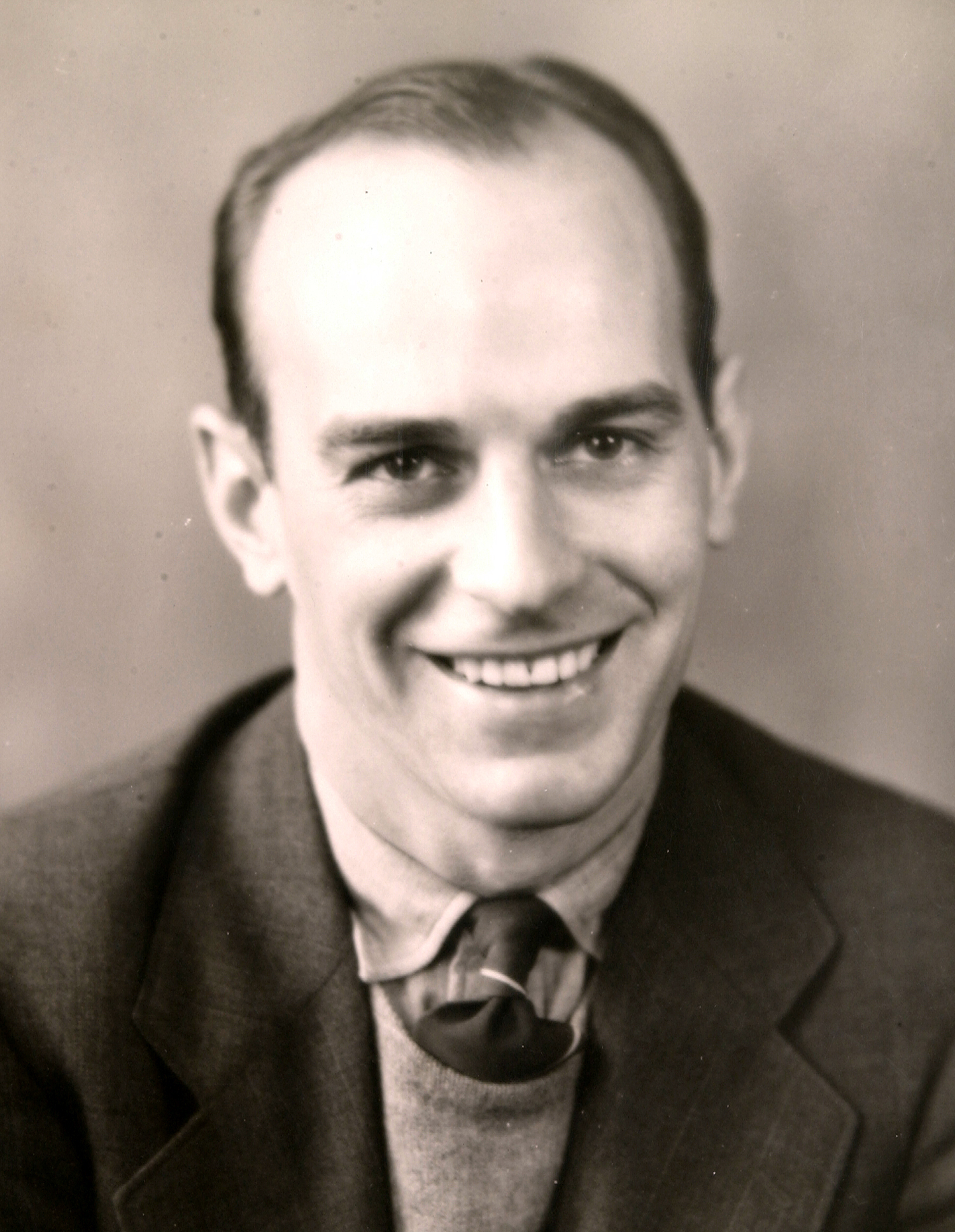 The greatest attributes Brown brought to team were innovative football schemes and player discipline. The coaching success he achieved while at Massillon is obvious from his record, where he utilized offenses he had learned from several college coaches. At the same time he leaned toward quickness instead of strength. He integrated the coaching schemes of the junior highs with that of the high school. And he insisted that every player make the team; there would be no cuts. In addition, he made sure his squad was properly fed.
The greatest attributes Brown brought to team were innovative football schemes and player discipline. The coaching success he achieved while at Massillon is obvious from his record, where he utilized offenses he had learned from several college coaches. At the same time he leaned toward quickness instead of strength. He integrated the coaching schemes of the junior highs with that of the high school. And he insisted that every player make the team; there would be no cuts. In addition, he made sure his squad was properly fed.
But the players mostly remember the discipline part. There were rules to be followed and discipline for breaking them. For example, players were required to stand during the games; no sitting on the bench. And always be on time for practices and meetings. No smoking or drinking; the penalty was removal from the team. No riding in a car. No dances. No dates. In bed by 10:00 pm.
“Don’t miss practice,” said former player Odell Gillom. “There was no excuse. And don’t stay out of school–or you’d hear it from Paul Brown. You’d hear it from all the coaches—the players, too. Brown would make them work harder. If you miss a day, you’re going to make up for it—because he was mad that you missed. You didn’t miss practice with Paul Brown, because you’d catch hell from him and the players.” (1)
“His was a fantastic way to do it,” said former player Mike Byhelene. “He came right to the point. He didn’t flower any speeches. He just came to exact words. He knew certain words, whether it was cutting, complimentary, to make you work harder or that he means business.” (1)
But Brown had also refined his coaching methods very early on. In fact, he was way ahead of other coaches in the Xs and Os and the ways to teach his methods to his players. And he stayed with those traits throughout his coaching career. “I was so obsessed with it, I don’t think I really knew my own limitations,” said Brown. (1)
“Brown’s methods were the same from high school to college to the pros, so it was easy for me to follow him,” said former player Tommy James. “I knew more what to expect, how he held his practices, better than some rookie coming in from college into pro ball. I went to college at Ohio State and he ran his practices just like he did here in Massillon” (1)
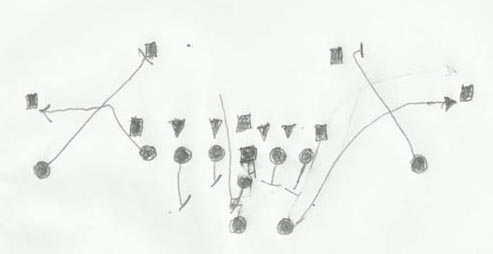
Brown was also an innovator. He tested the athletic capabilities of his players, instituting the 40-yard dash. He prepared playbooks. He developed the facemask. And he formed the Massillon Tiger Football Booster Club to support the players and coaches and address public opinion.
Although the team had initially worn tattered uniforms and played on a shoddy field, Brown turned his charges into a championship-caliber team within a year of taking over. Admission charges to the games took care of the uniform problem and later a new stadium remedied the field issues.
The following is a synopsis of his nine years as the coach of Massillon, where he compiled a record of 80-8-2 and captured six state and three national championships. He also recorded a 6-3 mark against Canton McKinley, winning his final six.
- 1932 – Won his first five games enroute to a 5-4-1 record. Lost to McKinley 19-0. Was nearly removed from the coaching position.
- 1933 – Finished 8-2 with losses to Barberton 6-0 and McKinley (9-1) 19-0.
- 1934 – Shut out the first nine opponents, including a 27-0 victory over Sharon, PA, which was coached by Dave Stewart. But lost to McKinley 21-6 in front of 20,000 fans, the largest ever crowd for an Ohio high school game. For the first time ever, both teams entered the contest undefeated. He also survived another removal attempt.
- 1935 – It all came together and the team finished with a 10-0 record with eight shutouts and was named both state and national champions. It was the highest scoring team in Massillon history up to that time (48 ppg). Brown defeated McKinley for the first time, 6-0.
- 1936 – Repeated as state and national champions with another 10-0 record and eight shutouts. Beat undefeated McKinley 21-0.
- 1937 – Slipped to 8-1-1, losing to New Castle (coached by Stewart) and tied Mansfield. Defeated unbeaten McKinley 19-6. Running back Bob Glass wrapped up his career during which he scored 47 touchdowns.
- 1938 – 10-0 record and state champs. Defeated unbeaten McKinley 12-0 in front of 18,000 fans. Held future pro running back Marion Motley to just 28 yards.
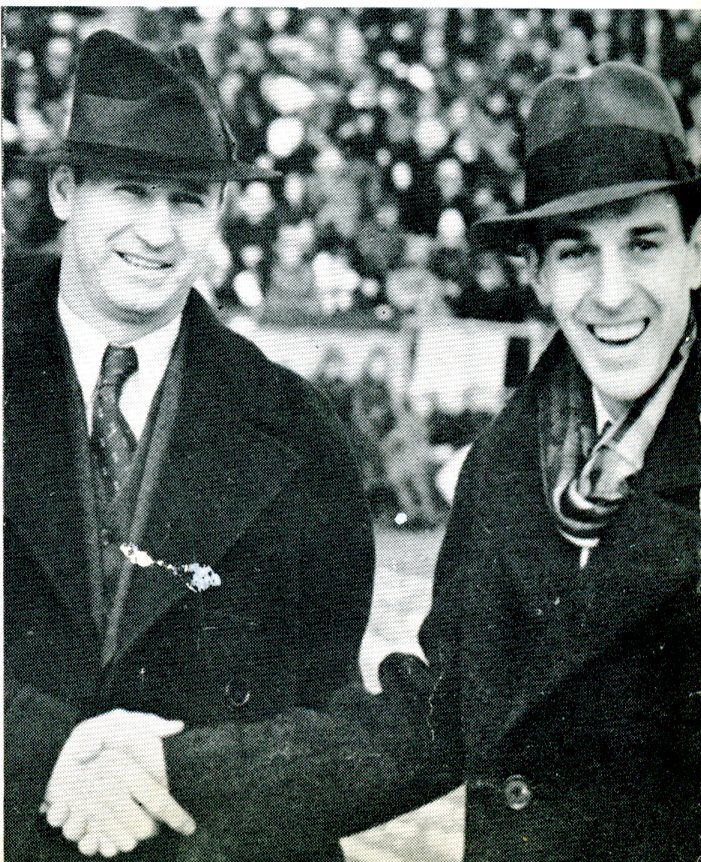
McKinley’s Jimmy Aiken and Massillon’s Paul Brown – 1936 - 1939 – Started the season by dedicating newly opened Tiger Stadium with a 40-13 victory over Cleveland Cathedral Latin. Continued the winning streak with another 10-0 record. Named both state and national champions. Beat McKinley 20-6 in front of 22,000 fans.
- 1940 – Final season at Massillon. Shut out the first nine opponents while compiling a 10-0 record, extending the winning streak to 33 games. Again, named both state and national champions. Averaged 48 points per game. Achieved the largest margin of victory over McKinley throughout the first 45 games in the series with a 34-6 win. The Bulldogs were the only team to dent the Tiger end zone. Defeated West Virginia state champion Weirton 48-0. Squashed Toledo Waite’s state title hopes with a 28-0 win. The entire starting lineup was named 1st Team All-Ohio.
Prior to the 1940 season Massillon traveled to Kent State University for a spring scrimmage and came out on top 47-0 (spring football was permitted in those days). “We went to scrimmage Kent State,” said former player Ray Getz. “We all got on the bus with our practice uniforms on. ‘The referees have striped shirts on. Paul Brown said, ‘They want a football game, you give it to them.’ We were only juniors then. It was in spring. We beat them so bad they walked off the field before the fourth quarter was over. We clobbered ‘em. They went on to win the conference (Ohio Conference) championship that year.” (1)
Brown also coached the Tiger basketball team, finishing state runner-up in 1937 and state semifinalist in 1940 and 1941.
There was nothing else to accomplish at Massillon and Ohio State was calling. So, Brown departed and headed to Columbus. Several assistant coaches also went into collegiate and professional coaching, some at Ohio State.
College Coaching
Brown was the head coach at OSU for three years, from 1941 to 1943, until the military called him up for service on account of World War II. He finished 6-1-1 during his first year, including a 3-1-1 Big 10 mark, and then captured the A.P. National Championship the following year with a 9-1 record, the lone loss coming to No. 3 Wisconsin on account of illnesses due to drinking bad water on the train. But, with his roster depleted during his third year on account of the war, the record slipped to 3-6.
Of course, as a high profile football coach, he was assigned in the military to lead the Great Lakes Naval Academy, a tour that lasted two years. His 1944 team finished 9-2-1 and was ranked No. 17 in the college poll. The following year the record was 6-4-1.
Professional Coaching and Management
With the war over, Brown returned to Ohio State, but failed to win back his job. The door to Southern Cal, his second choice, was also closed. So in 1946 he formed his own team in Cleveland as part of the professional All-American Football Conference (AAFC) and became both head coach and general manager. The team nickname? Browns, of course.
With limited rules in securing players, Brown was able boost salaries in order to bolster his lineup and his team ended up winning the conference championship in each of its four years in the AAFC, while compiling an overall mark of 47-3-2.
The professional game also provided an opportunity for Brown to explore new innovations, including the following:
- Tested the mental aptitude of his players to assess learning potential. His tests were the predecessor of the Wonderlic Test used by every NFL team today.
- Devised a method to send in plays from the coach. He would rotate two messenger guards who would relay the play to the quarterback in huddle.
- Placed a radio receiver in the quarterback’s helmet to save time in communicating plays. Although it was outlawed by the NFL shortly thereafter, it is currently in use today.
- Created the draw play, specifically for fullback Marion Motley.
- Invented the “taxi squad,” a group of promising players who did not make the roster, but were kept on reserve. To finance the taxi squad, Browns team owner, Mickey McBride, placed them on the payroll of his taxi company, although they did not actually drive cabs.
- During the game, located several assistant coaches in an elevated press box, who maintained constant communication with the sidelines. This provided a significant advantage over opponents.
With the Browns now lacking competition in the AAFC, it was time to test the waters of the NFL. And Brown again achieved immediate success. In fact, the Browns won the championship the first year out of the gate and then captured two more along with three runners-up during the next five years. Brown continued to coach through 1962, building his NFL record to 104-38-4, but a disagreement with new owner Art Modell following the 1962 season left him on the outs.
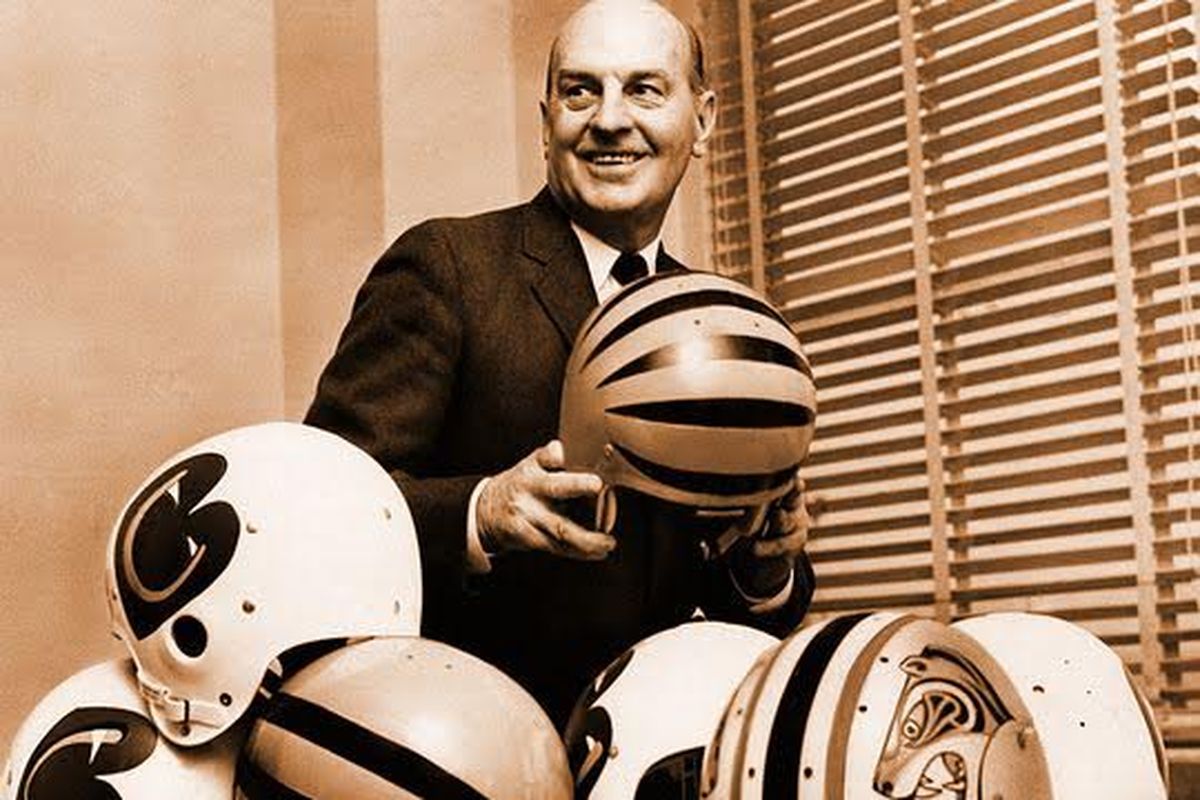
So once again, in 1968, it was time to form a new team. This time it was the Cincinnati Bengals. The colors?: orange and black, after Massillon. The nickname?: Bengals, like the tiger; but, not the Massillon Tigers. It was gleaned from tiger-face logo displayed on the front of the leather helmet of an early 1900s Cincinnati professional team.
Brown was owner, general manager and head of coach of the Bengals, and held those positions for eight years. After that, he was simply the owner, until 1991, the year he passed away. Brown’s team never made it to the Super Bowl while he was coach, but several teams did achieve divisional success, while his overall record was 55-56-1. But as General Manager, both his 1982 and 1989 teams did advance to the Super Bowl, losing both times to San Francisco in close games.
Brown’s son Mike now leads the Cincinnati Bengals. He was always impressed with his father’s approach to the game. “The intensity, that was always there,” he said. “The ability to organize. The ability to express himself forcefully, succinctly—that impressed players over a 50 year span.” (1)
During his professional career, Paul Brown was honored several times for his success:
- AP NFL Coach of the year 1970
- UPI NFL Coach of the Year 1957, 1969, 1970
- Sporting News Coach of the Year 1949, 1951, 1953
- Cleveland Browns Ring of Honor
- Cincinnati Bengals Ring of Honor
Postscript
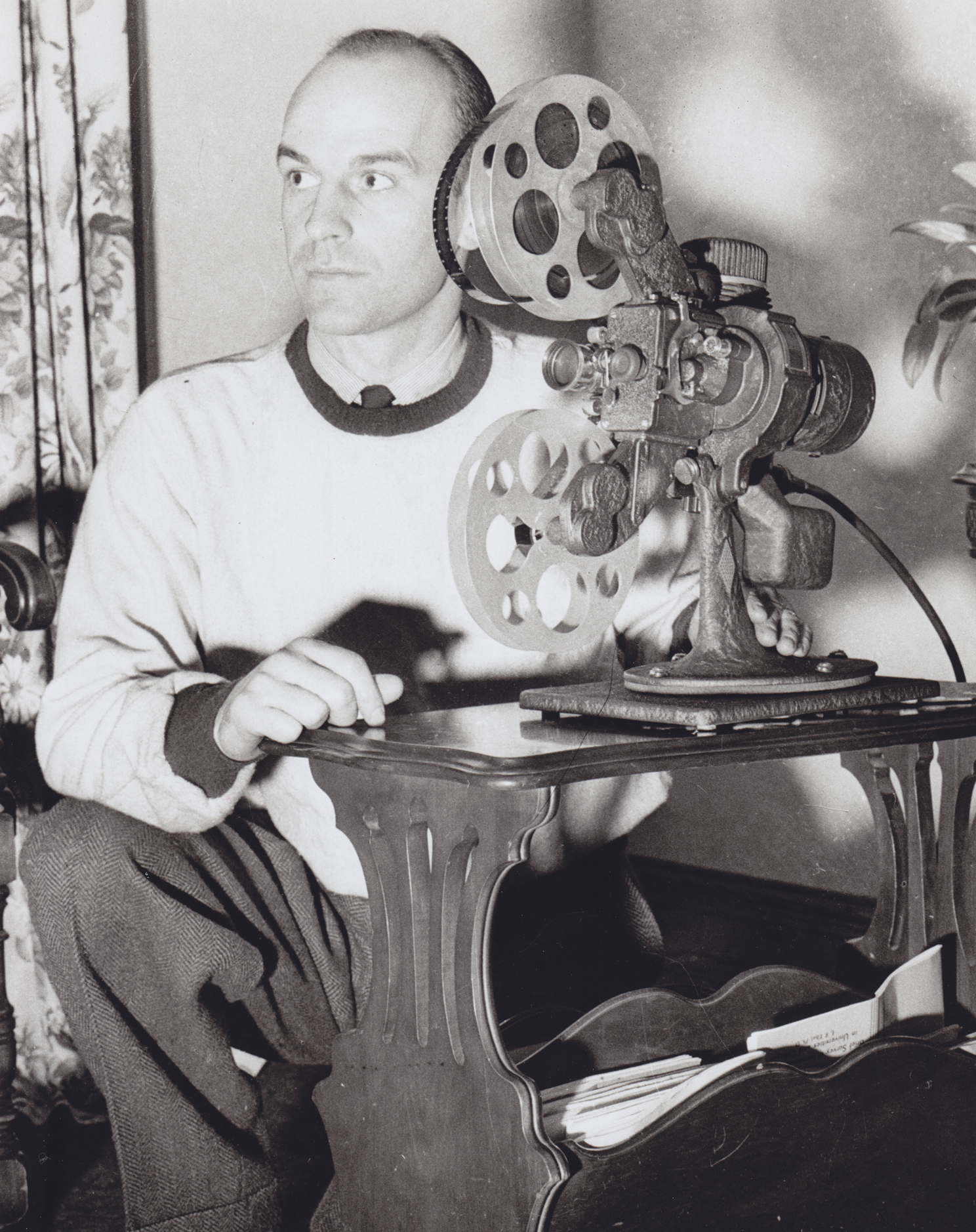 Brown coached at all levels of football in several different cities but always called Massillon home. “Paul loved Masssillon, said his sister Marian Evans. “Massillon was everything to him. He’d say, ‘When I die I want to go back to Massillon.’” (1)
Brown coached at all levels of football in several different cities but always called Massillon home. “Paul loved Masssillon, said his sister Marian Evans. “Massillon was everything to him. He’d say, ‘When I die I want to go back to Massillon.’” (1)
“When he was really famous and very successful, he never forgot his friends in Massillon,” said former teacher and friend Tom McConnaughy. “You just can’t imagine how tickled he was to see you and how anxious he was to do something for you.” (1)
Annually, he would visit Massillon’s Tiger Stadium just to have a look around. And in 1976 Massillon renamed the stadium in his honor: “Paul Brown Tiger Stadium.”
Brown married Kathryn Kester on June 10, 1929, and they had two sons, Mike and Robin. Paul died in Cincinnati at the age of 82 on August 5, 1991. And his body was brought back to Massillon according to his wishes.
- Massillon Memories, by Scott H. Shook, 1998
- Paul Brown, by Andrew O’Toole
